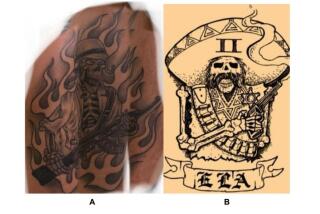Judge in Denny Beating Trial to Rule on Use of Enhanced Photo : Trial: Prosecutors say defendant Williams’ tattoo is visible in image taken from helicopter. The photographer identifies both defendants.
In the photograph it is barely distinguishable, a vague gray area on the left forearm.
But when that photo is enhanced, the image is identifiable as a rose tattoo.
Prosecutors say the tattoo is the same one that is on the left arm of Damian Monroe Williams, who along with Henry Keith Watson is charged with attempting to murder trucker Reginald O. Denny as rioting broke out at Florence and Normandie avenues last year.
Williams, 20, rolled up his left sleeve in Los Angeles Superior Court on Tuesday to reveal a rose tattoo similar to the one shown in the enhanced photos.
“We thought it was an appropriate time to nail down this identity issue once and for all,” Deputy Dist. Atty. Janet Moore, one of two prosecutors, said outside court. She said prosecutors already had presented evidence identifying Williams by his clothing and his gait, and that three eyewitnesses have said: “That’s him.”
“I can’t imagine what more this jury would need.” she said.
Robert Clark, photo editor for the Santa Monica Evening Outlook, shot the photo with a 400-millimeter lens attached to his camera as he hovered in a helicopter above the intersection April 29, 1992. That lens makes images eight times larger than they actually are, Clark testified Tuesday.
Jurors were allowed to examine an enlargement of Clark’s photo with a magnifying glass and to look at the tattoo on Williams’ arm. But they were not allowed to see the enhanced photos.
*
Judge John W. Ouderkirk excused the jury Tuesday as Moore and attorney Edi M. O. Faal, who represents Williams, questioned Leonid I. Rudin, director of research and development at Cognitech Inc., the Santa Monica firm where the photo was enhanced.
Ouderkirk will decide today whether to allow the enhanced photos to be admitted as evidence.
Prosecutors have videotapes of the attack on Denny, but Clark’s photos are clearer, Moore said. Clark gave copies of the photos to prosecutors last week when, he said, it became clear his pictures would be subpoenaed.
The district attorney’s office then “went into high gear with Cognitech” to have the photos enhanced, Moore said.
Independent of his photos, Clark identified Williams on Tuesday as the man who hit Denny on the head with a brick, and he identified Watson, 29, as the man who put his foot on Denny’s neck, holding him down on the pavement.
Moore asked if Clark could ever forget the brutal attack on Denny.
“To see one man smash another man in the head with a brick is just not acceptable in my code of conduct,” he said. “I could not believe what I was seeing.”
Williams and Watson also are charged with assaulting or robbing seven other people at Florence and Normandie, but Clark said he did not see those alleged attacks.
Clark was in the helicopter with reporter Robert A. Tur and others who had gone out to check community reaction to the not guilty verdicts returned in the trial of four officers charged with beating Rodney G. King.
Tur, who testified last week, was recalled to the witness stand Tuesday to present photographs made from his videotape showing a man he described as Williams carrying looted goods from Tom’s Liquor Store at the intersection.
Answering questions from Moore, Tur testified that Williams wore a white T-shirt, dark shorts and black-and-white sneakers as he left the store with both arms laden with booty. There was no stain on the back of the T-shirt near the left shoulder, he said.
During cross-examination by Faal, Tur said the looting videotape was shot just before 6 p.m. Faal then showed footage of another assault, taken at 6:25 p.m., showing that the man prosecutors say is Williams had a stain on his T-shirt.
Later, with Moore again asking the questions, Tur said Williams walked west on Florence and north on 71st Street with his loot. He said he saw Williams again at the intersection about 6:30 p.m., roaming around and stopping cars.
The stain has become a crucial point for defense lawyers who point out that a videotape shot at 71st and Normandie before rioting began shows the man prosecutors say is Williams wearing a shirt with the stain.
Defense attorneys ask how Williams could be at the liquor store afterward wearing a shirt with no stain, yet show up again in the intersection half an hour later with a stain.
Moore said last week that it is a reasonable assumption that Williams--who lives less than a five-minute walk from the intersection--went home to stash his goods and changed shirts.
“We are maintaining that there were two similarly dressed individuals at that intersection,” Faal said outside court.
The only way prosecutors can say the same man is wearing shirts with and without stains is to say one man interrupted his rioting to change shirts, he said.
More to Read
Sign up for Essential California
The most important California stories and recommendations in your inbox every morning.
You may occasionally receive promotional content from the Los Angeles Times.










